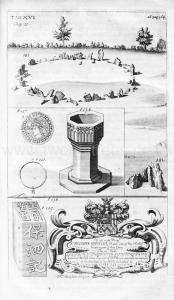The Natural History of Oxfordshire by Robert Plot
The Natural History of Oxfordshire by Robert Plot is in Prehistory.
The Natural History of Oxfordshire. Being an Essay towards the Natural History of England. By Robert Plot, LL.D. Late Keeper of the Ashmolean Museum and Professor of Chemistry in the University of Oxford. 1705.
Books, Prehistory, The Natural History of Oxfordshire by Robert Plot, The Natural History of Oxfordshire Chapter 10
80 And so again for the Fortification commonly called Round castle West of Begbrook Church but in the Parish of Bladen and Lineham Barrow [Map]. (between which and Pudlicot a Seat of the ancient Family of the Lacy's there is Passage under Ground down to the River) I can s little of them but in general tis most probable they were made by the Danes (they being both round) but upon what particular Occasion, I could no where find.
81 Beside the Circles of Earth cast up by the Danes there are others of Stone in many places of this Nation and particularly one here in the very Bounds of OxfordShire near Chipping norton in the Parish of Little Rollwright the Stones [Rollright Stones [Map]] being placed in Manner and Form and now remain as exactly engraven Tab 15 Fig 2222 in a Round of twixt 30 and 40 Paces over the tallest of them all which may be a Scale for the rest being about seven Foot high North of these about a Bolts shoot off on the other side the Hedge in the County of Warwick stands one singly alone upwards of nine Foot high in Form as described Fig 1 and Eastward five others as in Fig 3 about two Furlongs off the highest of them all about nine Foot also meeting formerly at the Top (as drawn by Mr Camden) with their tapering Ends almost in Shape of a Wedge since whose time there are two of them fallen down from the rest of which ancient Monument or what ever else it be he gives us in brief this following account.
82 Not far from Burford (he should have said Chipping Norton for Burford cannot be less than 7 or 8 Miles from it) upon the very Border of Oxfordshire is an ancient Monument to wit certain huge Stones placed in a Circle the common People call them Rollrich stones and dream they were sometimes Men by a miraculous Metamorphosis turned into hard Stones The highest of them all which without the Circle looketh into the Earth they call the King because he should have been King of England (forfooth) if he had once feen Long Compton a little Town lying beneath and which one may see if he go fome few Paces forward.
83 Other five standing [Whispering Knights Burial Chamber [Map]] on the other side touching as it were one another they imagine to have been Knights mounted on Horseback and the rest of the Army. These would I verily think says he to have been the Monument of some Victory and happily errected by Rollo the Dane who afterwards conquer'd Normandy; for what time he with his Danes troubled England with Depredations we read that the Danes joined Battle with the English at Hochnorton a place for no one thing more famous in old time than for the woful Slaughter of the English in that foughten Field under the Reign of King Edward the elder.
84 That this Monument might be erected by Rollo the Dane or rather Norwegian perhaps may be true but by no means about the time of Edward the elders for though it be true enough that he troubled England with Depredations yet that he made them in the Days of King Alfred I think all the ancient Historians agree, An 897 according to Florilegus but according to Abbot Bromton a much better Author in the Year 875 near 40 Years before that Slaughter of the English in King Edward's Days as will plainly appear upon Comparison of this with the 75 of the same Chapter.
